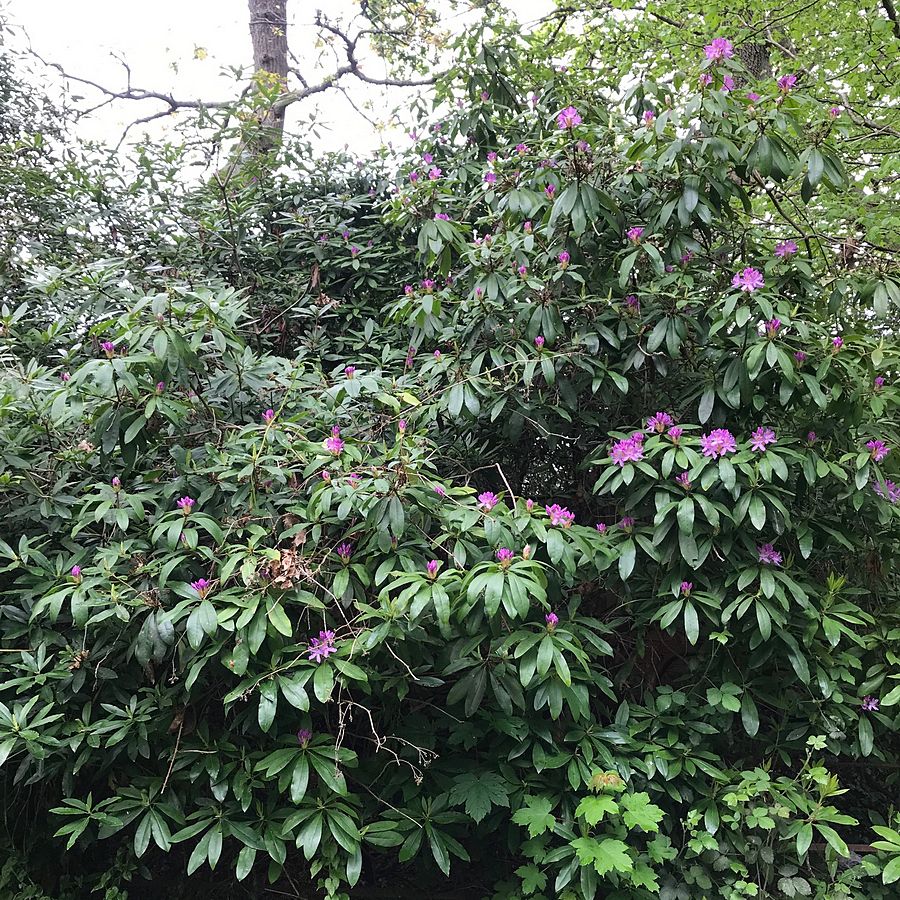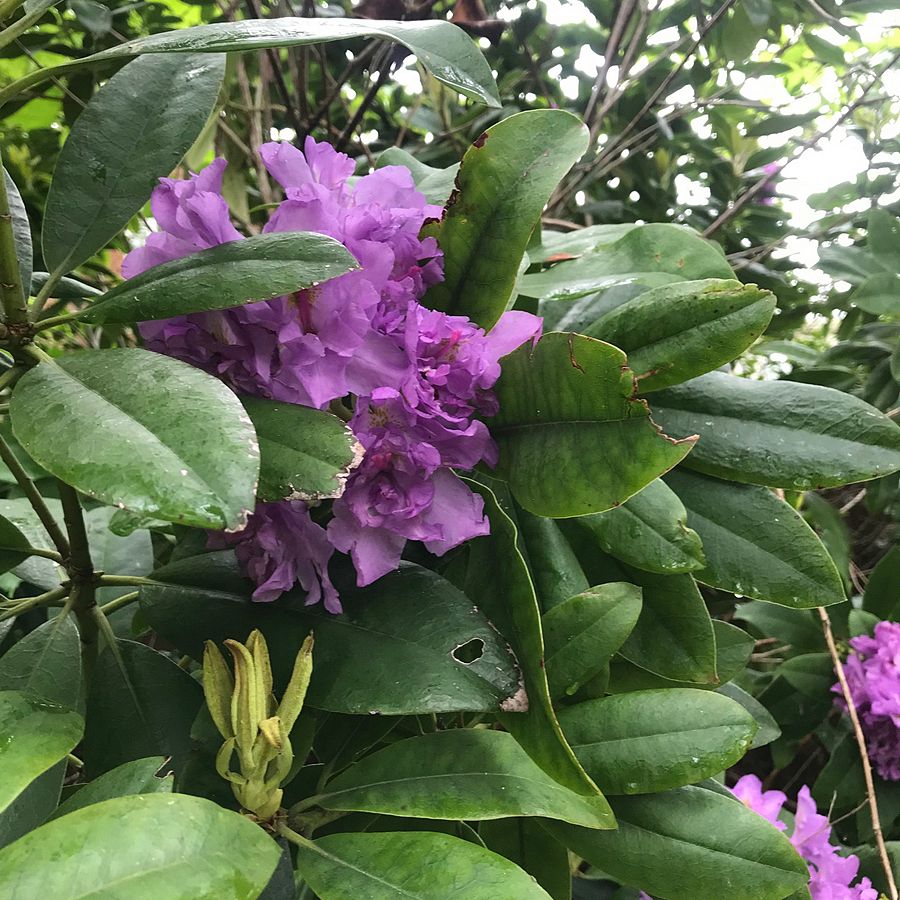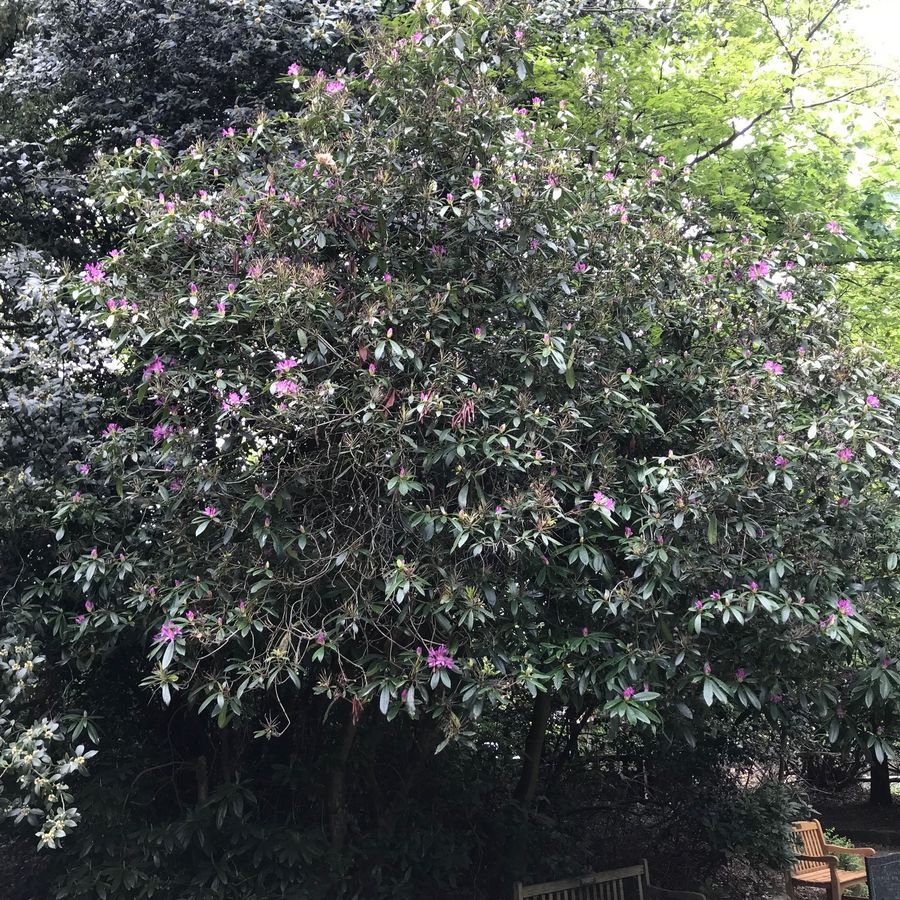Rhododendron Control & Removal
At Kustom Landscapes & Ecology, we specialise in Rhododendron Ponticum control and removal in Dorset, Hampshire, Wiltshire, Bristol & Bath, Gloucestershire, Somerset and Devon, along with a range of other invasive plants.
Rhododendron Ponticum is part of the vast Ericaceae family. Ericaceae roughly translates as heather or heath family. Rhododendron Ponticum’s pathway to the UK was via Gibraltar from Portugal and Spain but likely is to have spread from regions in Asia such as the Himalayas where many Rhododendron species have been traced to.
With large vivid pink to purple flowers in the spring and early summer there is little to imply its invasive nature but it has established as one of the biggest threats to biodiversity in the UK’s Woodlands and native habitats.
 Above ground Rhododendron Ponticum
Above ground Rhododendron Ponticum
Rhododendron Ponticum is a large evergreen shrub in appearance with dark oval long leaves between 6cm-20cm. The woody stems are solid and spread horizontally outwards creating foliage covered, dense growth. Rhododendron Ponticum can grow to exceed 5 meters in height and will create large areas of shade restricting ground vegetation. Leaves will remain live on stems for many seasons but will drop and regenerate. Leaf litter, detritus and a build-up of organic matter below the active growth, will aid in increasing the acidity of soil. Spring time sees large pink-purple flower heads containing a large quantity of viable seeds.
Below Ground Rhododendron Ponticum
Rhododendron Ponticum has a shallow but dense matt forming root system that will exploit food sources and oxygen, out competing any native flora in proximity. Lower branches as they gain mass, will potentially make contact with soils and form roots reproducing vegatively.
 Rhododendron Ponticum is classified as an invasive non-native species (INNS): http://www.nonnativespecies.org/home/index.cfm
Rhododendron Ponticum is classified as an invasive non-native species (INNS): http://www.nonnativespecies.org/home/index.cfm
Rhododendron Ponticum comes under this classification for these reasons:
- Growth rate and size- outcompetes native flora
- Different reproductive cycles and methods- can reproduce by seed and vegatively
- Resisitant to natural predators and pests – no native insects actively able to control plant quantities (toxic)
A key term we use to look at the effect of an invasive species such as Rhododendron Ponticum, is biodiversity which means the variety of animal, marine and plant species throughout the world or a particular area. Biodiversity is key to balancing ecosytems with all species contributing in some way to creating a precise environment which humanity is essentially the main beneficiary. When bio diversity is compromised the adverse knock on effect is vast. The biggest negative effects on biodiversity are:
- Climate change
- Deforestation and habitat loss
- Overexploitation (overharvesting, overhunting and overfishing)
- Invasive species
How does Rhododendron Ponticum effect biodiversity?
In the UK, Rhododendron Ponticum has acute adverse impacts to biodiversity. The presence of Rhododendron Ponticum effects the surrounding environment greatly by what is known as habitat modification:
Dense tall growth obscures light to smaller native plants and shrubs which produce flowers and fruit = denies food sources and pollination = reduced insect levels = reduction of small mammals, birds and amphibians’ food sources
Produces biochemicals that have been researched to cause inhibition of growth, germination and reproduction in other flora close by. This has been reported to have detrimental effect to areas where Rhododendron Ponticum has been removed meaning that little else will be able to grow back in the locality.
Toxicity in the leaves, stems and flowers from Grayanotoxins mean that the introduction of Rhododendron Ponticum to a habitat will not only begin to outcompete and strip away native Flora, but will also deny food source to insects and other herbivores as it is largely inedible. Bees that collect pollen from Rhododendron Ponticum, will produce a honey with Grayanotoxins present. This has been referred to as Mad Honey and if ingested by humans can cause symptoms anywhere from hallucinations to sudden drops in heartrate and blood pressure.
The introduction of Rhododendron Ponticum firstly as an ornamental and then into the wild has caused numerous changes in biodiversity and has impacted on the larger environment.
The biology of Rhododendron Ponticum means that it can harbor and act as a breeding ground for Pathogens that can be lethal to plant life and has been linked to sudden oak death in less hardy varieties. With almost yearly threats of disease and pests to our large native trees, failure to control Rhododendron Ponticum means another pathway to irreversible changes to the UK landscape.
Forrest and woodlands are probably the most important and vital habitats in the UK, and also a great source of recreation and tourism. Rhododendron Ponticum left to its own devices, quickly creates impenetrable thickets and barriers that can close up foot paths and thorough fairs, restricting access.
Brownsea Island in Poole Harbour, saw the National trust undertake a 50 year project to eradicate Rhododendron Ponticum that had run rampant across the 500 acre Site of Special Scientific Interest (SSSI) As one of the last locations where native Red Squirrels still survive, Rhododendron Ponticum had strangled the existing habitat and was a direct threat to the Red Squirrels food sources.
With costs in excess of £11 to eradicate Rhododendron Ponticum in a Snowdonia National Park, it is easy to gauge just how much the national expenditure could be.
Rhododendron Ponticum is a schedule 9 listed species in the wildlife and countryside act of 1981 which means a legal obligation to prevent the spread in the wild of species that may have detrimental effects to ‘ecological, environmental, or socio-economic’ interests.
There are 40 plants currently listed in schedule 9 of which Rhododendron is just one:
http://www.ukwildlife.com/index.php/wildlife-countryside-act-1981/schedule-9/schedule-9-part-2/
The increase of redevelopment of brownfield sites sees more and more contact with non-native invasive species. Sites and land that have been left derelict or un managed are optimum for the establishment of non-native species through vectors and lapsed biosecurity. The obligations of developers are to correctly deal with any non-native species like Rhododendron and can potentially hold up work or cease work whilst a management plan is undertaken or completed.
How can we help you?
What does a Rhododendron Survey consist of?
A request to survey will entail liaising onsite with a surveyor.
Regardless if you know exactly where the Rhododendron Ponticum is on the property or land, or you have difficulty identifying it, the first contact and chat with you is incredibly useful as you can provide a great deal of historical and geographical information. A thorough walk through of the site will reveal any evidence of Rhododendron Ponticum, even in the winter time there are always indicators. We would also be looking for clues and information as to how Rhododendron Ponticum arrived at the location in the first place and how to prevent it from contaminating the rest of the property or land, this is known as biosecurity.
The site will then be measured and any Rhododendron Ponticum plotted. It will also be established as to any Rhododendron in neighbouring properties or land.
The information will be presented in a survey report in which a site plan will be generated and additional research will have been obtained to clarify any evidence e.g. land registry or aerial maps
I have looked at your website and I’m sure that I have Rhododendron Ponticum am I breaking the law by having it on my property?
It is not illegal for you to have Rhododendron Ponticum on your property but it is your responsibility take on the role of remediating the problem if it appears to be spreading.
Ignoring the problem will effect not just your property and its localised environment, but your neighbours properties and any others natural areas such as park land, water ways and areas of social or special interest. Failure to acknowledge your responsibility could bring you to the attention of local authorities and the police who have the power to issue Community Protection Notices:
https://www.gov.uk/guidance/prevent-the-spread-of-harmful-invasive-and-non-native-plants
What is entailed in the control and eradication of Rhododendron Ponticum?
Manual Control can often be the first option if Rhododendron Ponticum is at a mature height. Cutting will immediately alleviate the sheer mass and shade that it can produce. This can help to encourage the return of native species. It is recommended that any arising’s, should they need to be removed from site, be classed as controlled waste. Application of Herbicide to cut the woody stumps can then be applied.
Stem injection is very successful and highly effective in the eradication of Rhododendron Ponticum and is ideal if Rhododendron Ponticum is growing in formal gardens, areas of special scientific interest (SSSIs), Special Protection Areas (SPAs) Special Areas of Conservation (SACs) or other ecological restraints.
Knapsack sprayer application is perfect for areas that do not contain specimen shrubs desirable, annuals, perennials, lawns and grasses in very close proximity. The delivery method is incredibly effective at getting full coverage of all above ground foliage of Rhododendron Ponticum.
Revegetation should always be a consideration once a management plan is in the completion phase. This is a crucial opportunity to reinstate biodiversity after an invasive attack and can also be an effective way to prevent other INNS from exploiting a vulnerable location.
What type of herbicides do you use? Are they harmful to humans and animals?
We use a glyphosate based herbicide which can only be obtained under licence and must pass through stringent health and safety testing.
There are no restrictions as regards to exclusion from the area for humans or animals after application. Glyphosate is a systemic, non-selective herbicide which only targets and inhibits certain enzymes in Plants, vital for protein conversion, growth and cell integrity
All our operatives must have passed a specific examination in the safe use of pesticides and herbicides before handling and applying to Japanese Knotweed or any other INNS.
In the event that Japanese Knotweed is close to water courses or ditches, application for consent will be made to the environment agency. Glyphosate is one of the very few herbicides that will be considered in use around water.
Glyphosate is also non residual meaning that it will dissipate on contact with soils and will not remain or contaminate. We follow closely, current legislation and would never actively use a product that put yourself, ourselves or animals at risk.
What areas of the UK do you cover?
Our invasive plants control and removal services cover the following counties: Dorset, Hampshire, Wiltshire, Bristol & Bath, Gloucestershire, Somerset and Devon.





